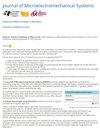Feedthrough Engineering to Enable Resonant Sensors Working in Conductive Medium for Bio Applications
IF 2.5
3区 工程技术
Q2 ENGINEERING, ELECTRICAL & ELECTRONIC
引用次数: 0
Abstract
Operating micro-nanoscale sensors in conductive liquids faces challenges due to liquid damping and high feedthrough floor, leading to low signal-to-feedthrough ratio. This work presents an innovative feedthrough engineering technique for resonant sensors immersed in ionic liquids, eliminating the need of isolation layers or additional processing for the sensing device. By leveraging the feedthrough path through substrate, the proposed technique counteracts the feedthrough induced by the ionic liquid, and successfully resumes the desired motional signal of the sensor. A thin-film piezoelectric-on-silicon (TPoS) resonator and oscillator operated in ionic environment are introduced to demonstrate that this technique not only enables the measurement of resonant signals in conductive liquids but also offers suitable options regarding the mode shape and resonant frequency of the sensor in different ion concentration environments. Additionally, the cancellation phenomenon shows potential as a concentration detector for ionic liquids. The fundamental (5MHz) and higher (15MHz) frequency modes of the PZT-based resonator are thoroughly investigated. Measurements show that regardless of the frequency where it operates, the resonator features decent stopband rejection (SBR) of around 18~20dB using the cancellation approach, which is even better than operating in deionized water. When employed as an oscillator, the results indicate a remarkable frequency resolution of approximately 1.8 Hz for both fundamental and higher mode frequencies. These measurements highlight the improved resonant behavior and real-time sensing capability offered by the proposed technique in conductive liquids. Such MEMS resonant transducers using this engineered feedthrough cancellation mechanism would serve as crucial building blocks for chemical and biosensing applications. [2023-0194]通过馈通工程实现可在导电介质中工作的共振传感器在生物领域的应用
在导电液体中操作微纳传感器面临着液体阻尼和高馈通底限的挑战,这导致了较低的信号馈通比。这项工作为浸入离子液体中的谐振传感器提出了一种创新的馈入工程技术,无需隔离层或对传感设备进行额外处理。通过利用穿过基底的馈通路,所提出的技术抵消了离子液体引起的馈通,并成功恢复了传感器所需的运动信号。介绍了在离子环境中运行的硅基薄膜压电(TPoS)谐振器和振荡器,以证明该技术不仅能在导电液体中测量谐振信号,还能在不同离子浓度环境中提供传感器模式形状和谐振频率的合适选择。此外,这种抵消现象还显示出作为离子液体浓度检测器的潜力。对基于 PZT 的谐振器的基频(5MHz)和高频(15MHz)模式进行了深入研究。测量结果表明,无论谐振器工作在哪个频率,采用抵消方法后,其阻带抑制(SBR)都能达到 18-20dB 左右,甚至优于在去离子水中工作时的阻带抑制。在用作振荡器时,结果表明基频和较高模式频率的频率分辨率均达到约 1.8 Hz。这些测量结果凸显了拟议技术在导电液体中改进的谐振行为和实时传感能力。使用这种工程馈入消除机制的 MEMS 共振传感器将成为化学和生物传感应用的关键构件。[2023-0194]
本文章由计算机程序翻译,如有差异,请以英文原文为准。
求助全文
约1分钟内获得全文
求助全文
来源期刊

Journal of Microelectromechanical Systems
工程技术-工程:电子与电气
CiteScore
6.20
自引率
7.40%
发文量
115
审稿时长
7.5 months
期刊介绍:
The topics of interest include, but are not limited to: devices ranging in size from microns to millimeters, IC-compatible fabrication techniques, other fabrication techniques, measurement of micro phenomena, theoretical results, new materials and designs, micro actuators, micro robots, micro batteries, bearings, wear, reliability, electrical interconnections, micro telemanipulation, and standards appropriate to MEMS. Application examples and application oriented devices in fluidics, optics, bio-medical engineering, etc., are also of central interest.
 求助内容:
求助内容: 应助结果提醒方式:
应助结果提醒方式:


